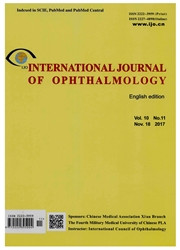

 中文摘要:
中文摘要:
AIM:To compare the efficacy and safety of combination of ranibizumab with photodynamic therapy(PDT)vs ranibizumab monotherapy in the treatment of age-related macular degeneration(AMD).METHODS:The Cochrane Central Register of Controlled Trials(CENTRAL)in the Cochrane Library,Pubmed,and Embase were searched.There were no language or data restrictions in the search for trials.Only randomized controlled trials(RCTs)were included.Methodological quality of the literatures was evaluated according to the Jadad Score.RevMan 5.2.6 software was used to do the meta-analysis.RESULTS:Seven studies were included in our systematic review,among which four of them were included in quantitative analysis.The result shows that the ranibizumab monotherapy group had a better mean best corrected visual acuity(BCVA)change vs baseline at month 12 compared with that of the combination treatment group,and the statistical difference was significant(WMD,-2.61;95%CI,-5.08 to-0.13;P=0.04).However,after the removal of one study,the difference between the two groups showed no significant difference(WMD,-2.29;95%CI,-4.81 to 0.23;P=0.07).Meanwhile,no significant central retinal thickness(CRT)reduction was found in the combination treatment group and the ranibizumab monotherapy group at 12 months follow-up.Nevertheless,the combination group tended to have a greater reduction in CRT(WMD,-4.13μm;95%CI,-25.88to 17.63,P=0.71).The proportion of patients gaining more than 3 lines at month 12 in the ranibizumab group was higher than in the combination group and there was a significant difference(RR,0.72;95%CI,0.54 to 0.95;P=0.02).Whereas there was no significant difference for the proportion of patients gaining more than 0 line at month12 between the two groups(RR,0.93;95%CI,0.76 to1.15;P=0.52).The general tendency shows a reduction in ranibizumab retreatment number in the combination treatment group compared with the ranibizumab monotherapy group.As major adverse events,the differences in the number of eye pain,endophthalmitis,hypertension and arterial t
 英文摘要:
英文摘要:
AIM:To compare the efficacy and safety of combination of ranibizumab with photodynamic therapy(PDT)vs ranibizumab monotherapy in the treatment of age-related macular degeneration(AMD).METHODS:The Cochrane Central Register of Controlled Trials(CENTRAL)in the Cochrane Library,Pubmed,and Embase were searched.There were no language or data restrictions in the search for trials.Only randomized controlled trials(RCTs)were included.Methodological quality of the literatures was evaluated according to the Jadad Score.RevMan 5.2.6 software was used to do the meta-analysis.RESULTS:Seven studies were included in our systematic review,among which four of them were included in quantitative analysis.The result shows that the ranibizumab monotherapy group had a better mean best corrected visual acuity(BCVA)change vs baseline at month 12 compared with that of the combination treatment group,and the statistical difference was significant(WMD,-2.61;95%CI,-5.08 to-0.13;P=0.04).However,after the removal of one study,the difference between the two groups showed no significant difference(WMD,-2.29;95%CI,-4.81 to 0.23;P=0.07).Meanwhile,no significant central retinal thickness(CRT)reduction was found in the combination treatment group and the ranibizumab monotherapy group at 12 months follow-up.Nevertheless,the combination group tended to have a greater reduction in CRT(WMD,-4.13μm;95%CI,-25.88to 17.63,P=0.71).The proportion of patients gaining more than 3 lines at month 12 in the ranibizumab group was higher than in the combination group and there was a significant difference(RR,0.72;95%CI,0.54 to 0.95;P=0.02).Whereas there was no significant difference for the proportion of patients gaining more than 0 line at month12 between the two groups(RR,0.93;95%CI,0.76 to1.15;P=0.52).The general tendency shows a reduction in ranibizumab retreatment number in the combination treatment group compared with the ranibizumab monotherapy group.As major adverse events,the differences in the number of eye pain,endophthalmitis,hypertension and arterial t
 同期刊论文项目
同期刊论文项目
 同项目期刊论文
同项目期刊论文
 Zinc Oxide Nanoparticles Induce Rat Retinal Ganglion Cell Damage Through Bcl-2, Caspase-9 and Caspas
Zinc Oxide Nanoparticles Induce Rat Retinal Ganglion Cell Damage Through Bcl-2, Caspase-9 and Caspas Diverse Roles of Natural Killer T Lymphocytes in Liver and Spleen in Mice with Experimental Autoimmu
Diverse Roles of Natural Killer T Lymphocytes in Liver and Spleen in Mice with Experimental Autoimmu Reactive oxygen species-induced cytotoxic effects of zinc oxide nanoparticles in rat retinal ganglio
Reactive oxygen species-induced cytotoxic effects of zinc oxide nanoparticles in rat retinal ganglio Mouse γδ T cells are capable of expressing MHC class II molecules, and of functioning as antigen-pre
Mouse γδ T cells are capable of expressing MHC class II molecules, and of functioning as antigen-pre Combintion of ranibizumab with photodynamic therapy vsranibizumab rnonotherapy in the treatment of a
Combintion of ranibizumab with photodynamic therapy vsranibizumab rnonotherapy in the treatment of a Regulation of interphotoreceptor retinoid-binding protein(IRBP)-specific Th1 and Th17 cells in anter
Regulation of interphotoreceptor retinoid-binding protein(IRBP)-specific Th1 and Th17 cells in anter 期刊信息
期刊信息
